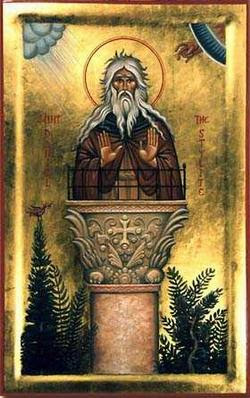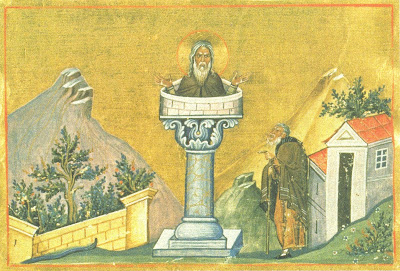

Saints martyrs AEITHALAS et APSEES. The Holy Martyrs Akepsimas and Aithalas were from Persia. Akepsimas was a pagan priest in the city of Arbel. Having received healing through the prayers of a Christian bishop, he was converted to the faith in Christ and boldly confessed it. For this they threw St Akepsimas into prison. Soon St Aithalas, a deacon of the Arbel Church, was imprisoned with him. They brought the martyrs before the ruler, where they again confessed their faith and were beheaded.
Saints martyrs TERENCE, VINCENT, EMILIEN et BEBAÏA, morts par le glaive.
Saints FUSCIEN, VICTORIC et GENTIEN, martyrs sous Dioclétien à Amiens en Picardie (287 ou 303).
Saint EUTYCHES (EUTYCHIUS, EUTYCHE, OYE), martyr à Mérida en Estrémadure ou à Cadix en Andalousie (IVème siècle).
Saints THRASON, PONTIEN et PRETEXTAT, martyrs à Rome sous Dioclétien (vers 302).
Saint BARSABAS et ses compagnons, martyrs en Perse par la main des Mazdéens sous Chapour Ier (342).
Saint DAMASE Ier, pape et patriarche de Rome (366-384), qui introduisit le latin dans les offices (384). (Office composé en français par le père Denis Guillaume et publié au tome XII du Supplément aux Ménées.) Spagnolo di origine, ma probabilmente nato a Roma, Damaso divenne Papa nel 366, dopo la pace costantiniana. Si adoperò affinché la catacombe non cadessero in rovina e non fosse perduta la memoria dei martiri. Man mano che ne rintracciava le tombe, le ornava di poetiche epigrafi di sua composizione. Ma non fu solo archeologo e letterato. Agì con fermezza di fronte al rappresentante del potere civile, l'imperatore, e commissionò a san Girolamo la traduzione in latino della Bibbia. Morì nel 384
Saint SAVIN (SABINUS), évêque de Plaisance en Emilie-Romagne (420). Savino, vescovo di Piacenza, pare fosse di Milano, diacono di quella comunità. Papa Damaso I - oggi unito a lui nella memoria della Chiesa - lo inviò nel 372 ad Antiochia per il Concilio d'Oriente, nel quale vennero discusse le dottrine ariane. Amico di sant'Ambrogio, scambiò con lui diverse lettere proprio sul tema della difesa della fede da quell'eresia. Fu pastore di Piacenza per ben 45 anni. La tradizione gli attribuisce, infatti, una lunghissima vita: 110 anni. Morì l'11 dicembre del 420, ma la sua festa si celebra a Piacenza con maggior solennità il 17 gennaio, giorno in cui le sue reliquie furono portate nella chiesa degli Apostoli, che da allora ha preso il suo nome
Synaxe de tous les saints martyrs de Géorgie.
Having examined the history of Georgia and the hagiographical treasures attesting to the faith of the Georgian nation, we become convinced that Heavenly Georgia— the legion of Georgian saints, extolling the Lord in the Heavenly Kingdom with a single voice—is infinitely glorious. It is unknown how many cleansed themselves of their earthly sins in merciless warfare with the enemy of Christ, or how many purified their souls in unheated cells through prayer, fasting, and ascetic labors.
To God alone are known the names of those ascetics, forgotten by history, who by their humble labors tirelessly forged the future of the Georgian Church and people.
St. George of the Holy Mountain wrote: “From the time we recognized the one true God, we have never renounced Him, nor have our people ever yielded to heresy.”
A decree of the Church Council of Ruisi-Urbnisi states: “We will not depart from thee, the Catholic Church which bore us in holiness, nor will we betray thee, our pride—Orthodoxy— to which we have always been faithful, for we have been granted the honor to know thee, the witness of the Truth Itself!” This relationship to Orthodoxy is the cornerstone of the life of every Georgian believer.
It is impossible to count the names of all those Christians who have been raised up from the earthly Church in Georgia to the heavens, let alone to describe all the godly deeds they have performed. For this reason December 11 has been set aside for the commemoration not only of the saints whose Lives are known to us but also of the nearly three hundred more whose names, but not stories, have been preserved as well.
Most Georgian people bear the name of a saint who is commemorated on this day, and they entreat the saint to intercede before the Lord in their behalf.



Saint DANIEL le Stylite, ascète près de Constantinople (493). (Office traduit en français par le père Denis Guillaume au tome XII des Ménées.)

San
Daniele lo Stilita, sacerdote, dopo la vita passata in monastero e dopo tante sofferenze sopportate, secondo l’usanza e l’esempio di san Simeone, decise di vivere sopra una colonna e vi rimase per trentatre anni e tre mesi, fino alla morte avvenuta a Costantinopoli, senza farsi spaventare dal freddo, dal caldo e dai venti.
APOLYTIKION. TONO 1
SEI DIVENUTO COLONNA DI PAZIENZA,* EMULANDO I ROGENITORI, O SANTO:* GIOBBE NEI PATIMENTI,* GIUSEPPE NELLE TENTAZIONI,* E IL MODO DI VITA DEGLI INCORPOREI,* PUR ESSENDO IN UN CORPO.* DANIELE, SANTO PADRE NOSTRO,* INTERCEDI PRESSO IL CRISTO DIO* PER LA SALVEZZA DELLE NOSTRE ANIME.

KONDAKION. TONO PL. 4 Quali primizie della natura
COME ASTRO DALLE MOLTE LUCI,* TU, O BEATO, SEI SALITO SULLA COLONNA,* E HAI DISSIPATO LA TENEBRA DELL’ERRORE,O PADRE:* FA’ DUNQUE RIFULGERE* NEL CUORE DEI TUOI SERVI* LA LUCE SENZA TRAMONTO DELLA CONOSCENZA.
EXAPOSTILARION. Nel sacro Spirito
TORCHIATO DAL FREDDO E DALLA CALURA,* O PADRE,* SOLLEVATO IN ALTO COL CORPO,* HAI RESISTITO SENZA PIEGARTI,* COME ACCIAIO,* ALLE NECESSITA’ DELLA NATURA,* O MIRRABILISSIMO DANIELE:* PER QUESTO DIO TI HA FATTO DEGNO* DI GODERE COME FIGLIO* DELLA GLORIA IMMORTALE .
Saint CIAN, ermite dans le pays de Galles (VIème siècle).
Saints VECHIANOS et NOMON, qui pratiquèrent l'ascèse dans l'île de Chypre.
Saints PIERRE l'Ascète et AKEPSIMAS.
Saint DAMASKINOS.
Saint PERIS, moine, éponyme de Llanberis au pays de Galles (VIIème siècle).
Saint AVRE (AUPRE, APER), prêtre au diocèse de Sens en Bourgogne, ermite près de La Chambre en Maurienne, éponyme de Saint-Avre en Maurienne (VIIème siècle).
Saint MIRAX, martyr en Egypte par la main des Musulmans (vers 640).
Saint TASSILON III, duc de Bavière, puis moine à Jumièges (794).
Saint FIVETIN (FIVETEIN, FIDIVITANUS, FIDWETEN), disciple de saint Convoyon, hiéromoine à Redon en Bretagne (vers 888).


Saint NICEPHORE II PHOCAS, empereur des Romains (963-969), célèbre par ses succès militaires comme par son amour de la vie monastique (969).
.jpg)
Saint LUC le Nouveau Stylite, ascète en Bithynie (979).

Saint NICON le Sec, de la Laure des Grottes de Kiev (1096 ou 1101).


Saint LEONCE d'Achaïe, ascète sur le mont Klokos (XIVème siècle).
Saint THEOPHANE (Ilmenski), évêque de Solikamsk, martyr par la main des Communistes avec DEUX prêtres et CINQ laïcs (Russie 1918).
Saint NICOLAS, prêtre, martyr par la main des Communistes (Russie 1937).
Saint JEAN, prêtre, martyr par la main des Communistes (Russie 1941).
Saint KOUKCHA (Vélitchko), moine du Grand-Habit à Odessa (Ukraine 1964).
Fête mobile: le dimanche entre le 11 et le 17 décembre, mémoire des ANCÊTRES du Seigneur. (Office traduit en français par le père Denis Guillaume au tome XII des Ménées.)
Nessun commento:
Posta un commento
Nota. Solo i membri di questo blog possono postare un commento.